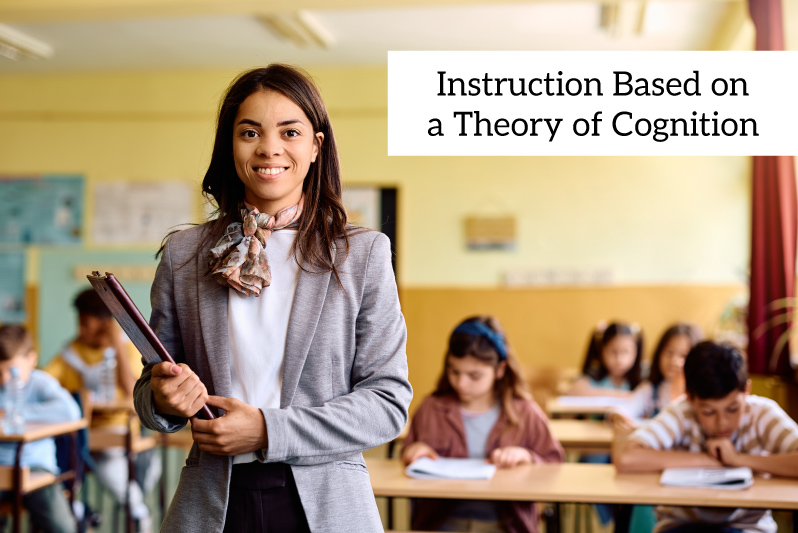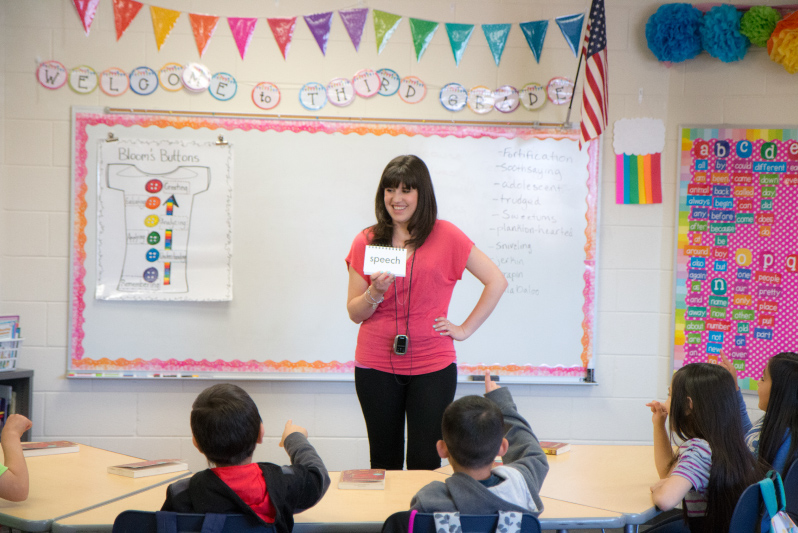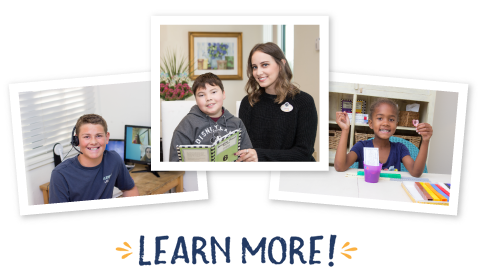
At Lindamood-Bell, our instructional approach aligns with a specific theory of cognition known as Dual Coding Theory (DCT). In this article, we’ll explore DCT and its practical applications in teaching, showing how a cognitive approach can boost literacy and comprehension.
The Imagery-Language Connection for Literacy

The following section is excerpted from Visualizing and Verbalizing® for Language Comprehension and Thinking, V/V® Teacher’s Manual, Second Edition (2007) by Nanci Bell:
“Language comprehension is the ability to connect to and interpret meaning for both oral and written language. It includes the ability to recall facts, get the main idea, infer, conclude, predict, and evaluate. Language comprehension is a cognitive act. Instruction in comprehension must align with a theory of cognition.
“The Visualizing and Verbalizing program (V/V) emerged from an experiential base, not a theoretical base. Years of experience teaching students to comprehend oral and written language eventually led to the sequential steps of V/V, a program specifically designed to develop language comprehension and thinking. In time, I learned that the principles of the Visualizing and Verbalizing program align with one of the most prominent theories in cognitive psychology—Dual Coding Theory.
“Allan Paivio, a cognitive psychologist, researcher, and the originator of Dual Coding Theory, has written extensively about the role of imagery in cognition. Paivio (2006) explains that ‘As its name suggests, the theory is based on the assumption that thinking involves the activity of two distinct cognitive subsystems, a verbal system specialized for dealing directly with language and a nonverbal system specialized for dealing with nonlinguistic objects and events.’
“Paivio and Mark Sadoski (2001) specifically connect Dual Coding Theory to language processing for reading:
Dual Coding Theory is the general theory of cognition that provides our unifying framework for literacy. This theory offers a comprehensive account of both verbal and nonverbal cognition. The inclusion of nonverbal aspects of cognition such as mental imagery is the most novel facet of this approach in a modern context, but it provides a comprehensive account of the verbal, linguistic aspects of cognition as well. Accordingly, it provides an explicit psychological account of literacy’s most central but elusive ingredient: meaning.
“Sadoski (2006) simplifies the theory: ‘Dual coding theory is a theory of mind in which all cognition consists of the independent activity of, or interplay between, two great mental codes: a verbal code specialized for language and a nonverbal code specialized for knowledge of the world in the form of mental images.’ The theory that more than just a single, verbal code is needed for language comprehension is consistent with my numerous years of experience teaching students to comprehend and interpret language. Without the sensory information of imagery, words have no meaning, neither individually nor connected together to form concepts. The single code of language cannot do the job alone. Imagery plays a role in both concrete and abstract language comprehension.
“Both codes are based on a substrate of imagery, or mental representations. DCT is distinctive from other theories of reading in that processing – activation of memory for decoding sounds and letters or getting meaning from language – can occur between two sensory modalities (verbal and nonverbal), whereas other theories of reading account for one modality (verbal), including reading models for phonics, morphology, and syntactic/semantic artifacts of literacy.
“Clinical research and experience over the last twenty-five years indicate that there is a language comprehension disorder that unfortunately is rarely identified. This separate comprehension weakness often undermines the reading process and goes beyond use of context, phonological processing, word recognition, oral vocabulary, prior knowledge, and background experience. It is a weakness based in the sensory system in creating an imaged gestalt.”
For decoding and encoding, the brain’s imaginal sensory system (the sensory forms of information used to load memory) includes phonemes and graphemes in a multisensory fashion in the auditory and visual systems, respectively, necessary to read and spell fluently. In DCT, visual memory and auditory/articulatory memory are integrated for word reading skills.
As students learn sounds and letters and begin decoding words with phonemic awareness, DCT then accounts for recognition of familiar spelling patterns and memory associated with word recognition. This enables automaticity in decoding, which is necessary to become proficient in the reading process. As Sadoski, McTigue, and Paivio (2012) describe:
“Based on our reading experience some associations [of orthographic conventions or context] become so high in probability that they become overlearned and “automatic.”
“This is the DCT account of automaticity, the term used in the LS model to indicate the rapid association of a spelling with a pronunciation with little or no conscious attention.”
Automaticity – essential for word recognition, fluency, and comprehension – is often weak for readers who need stimulation in imagery (mental representations), enabling them to store and access words in memory.
Sensory-Cognitive Instruction for Reading and Comprehension

Reading is not just a learned skill but a cognitive act, requiring that any effective approach to reading aligns with core cognitive principles. Learning to read involves the multisensory integration of auditory (phonological), visual (orthographic), and linguistic processing, as well as cognitive functions like mental imagery, working memory, long-term memory, and metacognition.
To build skilled readers, it is crucial to understand the sensory-cognitive factors underlying essential reading skills, such as letter-sound knowledge, phonics, orthography, fluency, vocabulary, and comprehension. Phonological awareness, an important sensory-cognitive skill for reading, is widely recognized as essential. Patricia Lindamood, one of Lindamood-Bell’s founders, pioneered much of the research and development around phonemic awareness, underscoring its foundational role in reading development.
Beyond phonological awareness, Lindamood-Bell emphasizes two other sensory-cognitive processes that are often overlooked yet crucial for literacy and learning: symbol imagery and concept imagery. These processes play a fundamental role in a student’s ability to decode text and understand its meaning. For many struggling readers, these two factors are missing or underdeveloped, and most instructional methods do not focus on explicitly developing these skills. Symbol imagery aids in the visualization and recall of sounds, letters, words, and spelling patterns. In contrast, concept imagery supports comprehension by enabling students to form mental representations of oral language and text.
This emphasis on imagery is rooted in the well-established cognitive theory known as Dual Coding Theory (DCT). DCT suggests that cognitive processes involving both language and imagery significantly enhance memory, comprehension, and critical thinking. It sheds light on how mental representations, memory, and metacognition impact learning outcomes.
Today, a typical reading approach focuses heavily on phonological awareness and phonics, often with insufficient emphasis on orthographic processing, fluency, or comprehension—all of which are essential for reading automaticity and proficiency. While phonological awareness and phonics are critical foundational skills, they are not sufficient on their own. For struggling readers, it is essential to address the sensory-cognitive skills of symbol imagery and concept imagery, which amplify their potential to grasp the full range of reading components.
For emerging readers (K-2), developing these skills early lays a stronger foundation for reading success, potentially reducing the likelihood of later reading struggles. Lindamood-Bell’s comprehensive, imagery-based approach to literacy is supported by an extensive research base, offering a balanced, cognitive-based pathway to skilled, confident reading.
Sensory-cognitive instruction results in significant gains in reading, comprehension, and math, allowing students to:
- Achieve rapid progress: In just weeks of instruction, many students experience measurable improvements in reading and comprehension, sometimes achieving years’ worth of progress.
- Overcome learning loss and move ahead: By actively engaging both imagery and language, students can bridge gaps in learning, recover lost skills, and gain a lasting academic edge.
- Build confidence and success: As students strengthen their learning ability, they gain the skills and confidence to handle new challenges.
Peer-Reviewed Research

Lindamood-Bell regularly collaborates with research institutions to study the efficacy of our approach. In a study conducted by Texas A&M researchers, Lindamood-Bell partnered with Pueblo District 60 in Pueblo, Colorado, to implement an initiative based on a theory of cognition to improve Colorado Student Assessment Program reading scores.
Students received Seeing Stars, Visualizing and Verbalizing, and Lindamood Phoneme Sequencing instruction to develop symbol imagery, concept imagery, and phonemic awareness. This study investigated the effect of dual coding theory using the Seeing Stars and Visualizing and Verbalizing programs. Instruction was delivered by Pueblo City Schools teachers trained in the programs. Student gains were measured with the state reading test. The results were compared to gains made by students from other, similar schools in Colorado who did not receive Lindamood-Bell instruction. Schools were comparable due to controlling for school size, free and reduced-price lunch, and minority populations. Third-grade results for Title I schools are provided below.

Results
The line in the chart above shows the percentage point difference (in percent proficient and advanced on the state reading test) between Pueblo (Lindamood-Bell) schools and comparison schools. By 2003, schools partnering with Lindamood-Bell were 26 percentage points above the average of the comparison schools. The independent evaluators who conducted this research determined that the main effect of Lindamood-Bell instruction was statistically significant (p < .0001). In their published article they state that “[Pueblo] Title I schools outperformed the average of the remaining comparable Title I schools in the state in an increasingly positive way during the years 1998-2003.” The results of this study support the dual coding theory model of cognition and illustrate that Lindamood-Bell instruction in the Seeing Stars, Visualizing and Verbalizing, and Lindamood Phoneme Sequencing programs lead to improved reading, which is essential to achieving success with school curricula.
Access the full article, “Effects of a Theoretically Based Large-Scale Reading Intervention in a Multicultural Urban School District,” published in the American Educational Research Journal.
Support for Educators

Ready to teach using a sensory-cognitive approach? Lindamood-Bell offers educators professional development in evidence-based programs designed to elevate instructional practices and improve student outcomes. Our workshops, available both in person and live online, provide in-depth training to enhance instructional practices and improve student outcomes. Schools can also partner with us for inservices, job-embedded coaching, and comprehensive school partnerships.
Help for Struggling Readers
Symbol Imagery for Phonological and Orthographic Processing in Reading and Spelling
Lindamood Phoneme Sequencing (LiPS)
Phonemic Awareness for Reading, Spelling, and Speech
Help for Poor Comprehension Skills
Visualizing and Verbalizing (VV)
Concept Imagery for Language Comprehension, Thinking, and Memory
Foundational Development in Concept Imagery, Oral Language Comprehension, and Expression
Contact Lindamood-Bell today. Click here to schedule a brief consultation with a program expert to discuss your intervention needs. We look forward to partnering with you to boost reading, comprehension, and math for your students!





